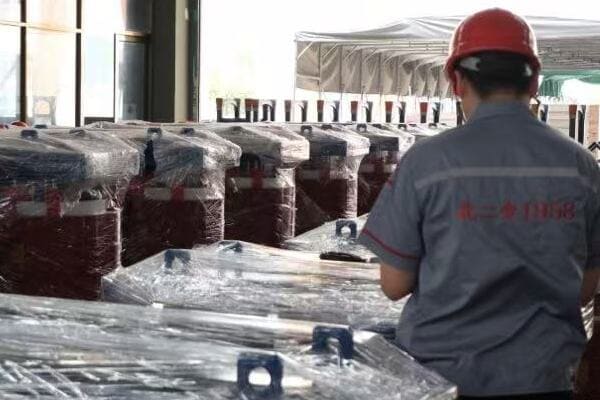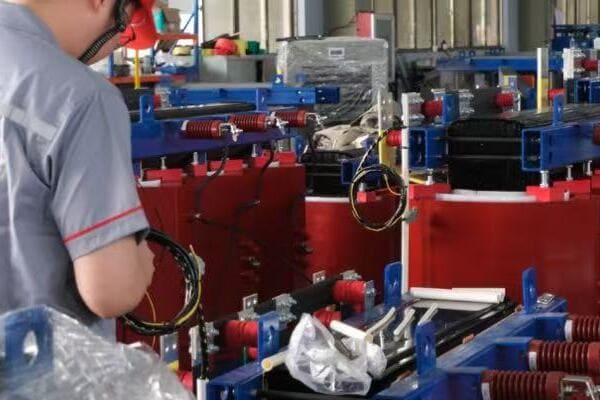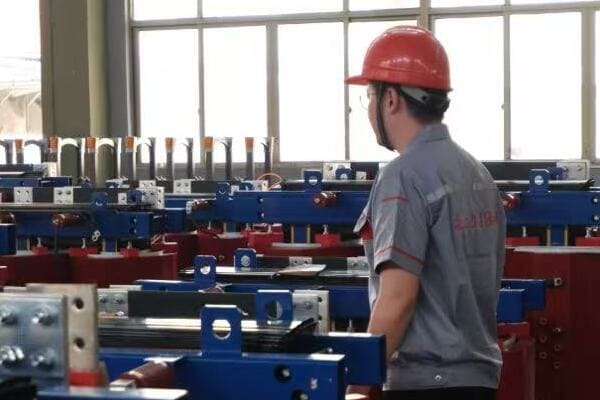Dry Type Transformer Types Price Guide 2025: What Factors Influence the Cost?
Are you struggling to understand why dry type transformer prices vary so much? You’re not alone. Many buyers find the pricing landscape confusing and unpredictable.
The cost of dry type transformers in 2025 is influenced by raw material prices, technological advancements, market demand, production scale, regulatory requirements, and customization needs. Understanding these factors is crucial for making informed purchasing decisions and budget planning.

As someone who’s been in the transformer industry for over two decades, I’ve seen firsthand how these factors interplay to determine prices. Let’s dive into the key elements that will shape transformer costs in 2025.
Dry Type Transformer Market Overview 2025: Types and Price Ranges?
Are you wondering what types of dry type transformers will dominate the market in 2025 and how much they’ll cost? This is a common concern for many buyers and project planners.
In 2025, the dry type transformer market will feature cast resin, vacuum pressure impregnated (VPI), and open-wound types. Prices will range from $5,000 to $500,000 depending on capacity, with cast resin types commanding premium prices due to their superior performance and durability.

Let me break down the market landscape based on my industry insights:
Cast Resin Transformers: The Premium Choice
Cast resin transformers will continue to lead in high-end applications:
-
Price Range:
- Small (up to 500 kVA): $15,000 – $50,000
- Medium (500 kVA – 2500 kVA): $50,000 – $200,000
- Large (above 2500 kVA): $200,000 – $500,000
-
Key Features:
- Excellent fire resistance
- High short-circuit strength
- Low maintenance requirements
-
Applications:
- High-rise buildings
- Hospitals
- Data centers
I recently worked on a project for a new hospital where we chose a 2000 kVA cast resin transformer. Despite the higher upfront cost of $180,000, the client saw the value in its safety features and low maintenance needs.
Vacuum Pressure Impregnated (VPI) Transformers: The Versatile Option
VPI transformers will offer a balance of performance and cost:
-
Price Range:
- Small (up to 500 kVA): $10,000 – $40,000
- Medium (500 kVA – 2500 kVA): $40,000 – $150,000
- Large (above 2500 kVA): $150,000 – $400,000
-
Key Features:
- Good thermal performance
- Suitable for both indoor and outdoor use
- Cost-effective for medium-range applications
-
Applications:
- Industrial plants
- Commercial buildings
- Renewable energy projects
For a recent solar farm project, we opted for a 1500 kVA VPI transformer priced at $120,000. It offered the right balance of performance and cost for the outdoor setting.
Open-Wound Transformers: The Economic Choice
Open-wound transformers will remain popular for basic applications:
-
Price Range:
- Small (up to 500 kVA): $5,000 – $25,000
- Medium (500 kVA – 1000 kVA): $25,000 – $80,000
- Large (above 1000 kVA): $80,000 – $200,000
-
Key Features:
- Most cost-effective option
- Suitable for clean, dry environments
- Easy maintenance and inspection
-
Applications:
- Small commercial spaces
- Light industrial use
- Temporary installations
I recently advised a small workshop owner who needed a 300 kVA transformer. We went with an open-wound type priced at $18,000, which perfectly met their needs and budget.
Price Comparison Table: Dry Type Transformer Types in 2025
| Transformer Type | Small (≤500 kVA) | Medium (500-2500 kVA) | Large (>2500 kVA) |
|---|---|---|---|
| Cast Resin | $15,000 – $50,000 | $50,000 – $200,000 | $200,000 – $500,000 |
| VPI | $10,000 – $40,000 | $40,000 – $150,000 | $150,000 – $400,000 |
| Open-Wound | $5,000 – $25,000 | $25,000 – $80,000 | $80,000 – $200,000 |
It’s important to note that these price ranges are estimates and can vary based on specific requirements, manufacturer, and market conditions. In my experience, the key to getting the best value is not always choosing the cheapest option, but finding the transformer that best fits your specific needs and operating environment.
For instance, I once worked with a client who initially wanted to go with the cheapest open-wound option for their new office building. After discussing their long-term plans and the potential for expansion, we decided on a slightly more expensive VPI transformer. This decision proved wise when they expanded their operations two years later, as the VPI transformer could handle the increased load without needing a replacement.
Remember, when considering prices, factor in not just the upfront cost but also the total cost of ownership, including energy efficiency, maintenance needs, and expected lifespan. In 2025, I expect we’ll see an even greater emphasis on energy efficiency and smart features, which might increase upfront costs but offer significant savings over the transformer’s lifetime.
Raw Material Trends: Impact on Dry Type Transformer Pricing in 2025?
Are you concerned about how raw material costs will affect transformer prices in 2025? You should be. Raw material trends are one of the most significant factors influencing the cost of dry type transformers.
In 2025, the prices of key raw materials like copper, electrical steel, and insulation materials will significantly impact dry type transformer costs. Fluctuations in these materials can cause price swings of 10-30% in the final product, making it crucial for buyers to understand these trends.

Let me break down the key raw materials and their expected impact on pricing:
Copper: The Conductor Conundrum
Copper is a critical component in transformer windings:
-
Price Trend:
- Expected to rise 15-20% by 2025 due to increased global demand
- Volatility linked to economic factors and green energy initiatives
-
Impact on Transformer Cost:
- Can account for 30-40% of material costs in a dry type transformer
- A 20% increase in copper prices could lead to a 6-8% increase in overall transformer cost
-
Industry Response:
- Some manufacturers exploring aluminum as an alternative
- Advanced winding techniques to optimize copper usage
I recently worked on a project where copper prices surged midway through production. We had to renegotiate contracts with clients, highlighting the importance of price escalation clauses in long-term agreements.
Electrical Steel: The Core Issue
Electrical steel is crucial for the transformer core:
-
Price Trend:
- Projected 10-15% increase by 2025
- Supply chain disruptions and increased demand from EV sector driving prices up
-
Impact on Transformer Cost:
- Represents 20-25% of material costs in dry type transformers
- A 15% rise in electrical steel prices could increase transformer costs by 3-4%
-
Industry Adaptation:
- Research into amorphous metal cores for higher efficiency
- Improved core design to reduce material usage
In a recent large-scale project, we opted for amorphous metal cores despite the higher initial cost. The improved efficiency offset the price difference within three years of operation.
Insulation Materials: The Hidden Cost Driver
Insulation materials are essential for transformer safety and performance:
-
Price Trend:
- Expected 5-10% increase by 2025
- Driven by advancements in material technology and environmental regulations
-
Impact on Transformer Cost:
- Accounts for 10-15% of material costs
- A 10% increase in insulation material prices could lead to a 1-1.5% rise in transformer cost
-
Technological Advancements:
- Development of bio-based insulation materials
- Nano-enhanced insulation for better performance
We recently used a new type of nano-enhanced insulation in a high-performance transformer. While it increased the cost by 2%, it allowed for a more compact design and better thermal performance.
Resin (for Cast Resin Transformers): The Encapsulation Equation
For cast resin transformers, the epoxy resin is a significant cost factor:
-
Price Trend:
- Projected 8-12% increase by 2025
- Influenced by oil prices and chemical industry dynamics
-
Impact on Transformer Cost:
- Can represent 15-20% of material costs in cast resin transformers
- A 10% increase in resin prices could lead to a 1.5-2% rise in overall cost
-
Industry Innovations:
- Research into more environmentally friendly resin formulations
- Improved casting techniques to reduce resin usage
In a recent project for a coastal installation, we used a new type of resin with enhanced moisture resistance. The 5% cost increase was justified by the improved longevity in the harsh environment.
Raw Material Cost Impact Table
| Material | Expected Price Increase by 2025 | Impact on Transformer Cost |
|---|---|---|
| Copper | 15-20% | 6-8% increase |
| Electrical Steel | 10-15% | 3-4% increase |
| Insulation Materials | 5-10% | 1-1.5% increase |
| Resin (Cast Resin Types) | 8-12% | 1.5-2% increase |
These trends underscore the importance of material cost management in transformer pricing. In my experience, successful manufacturers and buyers in 2025 will be those who can navigate these raw material trends effectively.
Strategies I’ve seen work well include:
- Long-term supply agreements to stabilize prices
- Investing in R&D to reduce material dependency or find alternatives
- Implementing lean manufacturing techniques to minimize waste
- Considering total cost of ownership, not just initial material costs
For example, in a recent large-scale procurement, we negotiated a two-year price agreement with suppliers, with limited escalation clauses tied to specific raw material indices. This approach provided price stability for our clients while allowing for fair adjustments based on market conditions.
Remember, while raw material costs are a significant factor, they’re not the only consideration in transformer pricing. The key is to balance material costs with performance, efficiency, and long-term reliability to get the best value for your investment.
Technology and Efficiency: How Innovations are Shaping Costs?
Are you wondering why some new transformer models seem more expensive than older ones? The answer often lies in technological advancements and efficiency improvements.
Innovations in transformer technology, such as advanced core materials, smart monitoring systems, and improved insulation, are influencing costs in 2025. While these innovations may increase upfront prices, they often lead to significant long-term savings through improved efficiency and reduced maintenance needs.

Let me break down how these technological advancements are affecting transformer costs:
Advanced Core Materials: The Efficiency Game-Changer
New core materials are revolutionizing transformer efficiency:
-
Amorphous Metal Cores:
- 20-30% more expensive than traditional silicon steel
- Reduces no-load losses by up to 70%
- Can lead to significant energy savings over transformer lifetime
-
High-Grade Grain-Oriented Electrical Steel:
- 10-15% price premium over standard grades
- Improves overall efficiency by 0.5-1%
- Particularly beneficial for large, high-load transformers
-
Cost Impact:
- Can increase initial transformer cost by 5-10%
- Often results in ROI within 3-5 years through energy savings
I recently worked on a project where we used amorphous metal cores in a substation transformer. The initial cost was 15% higher, but the energy savings are projected to exceed $100,000 over ten years.
Smart Monitoring and Diagnostics
Intelligent systems are becoming standard in modern transformers:
-
IoT Sensors and Monitoring Equipment:
- Adds $5,000-$20,000 to transformer cost, depending on complexity
- Enables real-time monitoring and predictive maintenance
- Can extend transformer life by 10-15% through early issue detection
-
AI-Driven Diagnostic Systems:
- Premium of $10,000-$30,000 for advanced systems
- Predicts potential failures and optimizes performance
- Reduces maintenance costs and downtime significantly
-
Cost-Benefit Analysis:
- Increases initial cost by 3-8% for medium to large transformers
- Can reduce total ownership cost by 10-20% over transformer lifespan
In a recent industrial installation, we implemented an AI-driven monitoring system. Despite the $25,000 additional cost, it prevented a major failure within the first year, saving the client an estimated $200,000 in potential downtime and repairs.
Improved Insulation Technologies
Advancements in insulation are enhancing performance and longevity:
-
Nano-Enhanced Insulation Materials:
- 15-25% more expensive than traditional materials
- Improves thermal performance and extends transformer life
- Allows for more compact designs in some cases
-
Bio-Based Insulation:
- Currently at a 20-30% price premium
- Environmentally friendly and potentially easier to dispose of
- May become more cost-competitive by 2025 as production scales up
-
Impact on Transformer Cost:
- Can increase overall cost by 2-4%
- Often justified by improved performance and longer lifespan
We recently used nano-enhanced insulation in a transformer for a data center. The 3% cost increase was offset by the ability to handle higher loads and reduce cooling needs.
Energy Efficiency Improvements
The push for higher efficiency is driving up initial costs but reducing long-term expenses:
-
High-Efficiency Models (Beyond Standard Requirements):
- 10-20% price premium over standard efficiency models
- Can reduce energy losses by 15-30%
- Particularly important in applications with high utilization rates
-
Advanced Cooling Systems:
- Adds 5-10% to transformer cost
- Improves efficiency and allows for higher power density
- Crucial for compact installations or harsh environments
-
Cost-Efficiency Trade-off:
- Higher upfront costs are typically recovered in 3-7 years through energy savings
- Becoming increasingly important due to rising energy costs and environmental regulations
In a recent project for a large manufacturing plant, we opted for a high-efficiency transformer with an advanced cooling system. The 15% price premium is expected to be recovered in just four years through reduced energy costs.
Technology Impact on Transformer Costs: Comparative Table
| Technology | Initial Cost Increase | Long-Term Benefits | Typical ROI Period |
|---|---|---|---|
| Amorphous Metal Cores | 5-10% | 20-30% energy savings | 3-5 years |
| Smart Monitoring Systems | 3-8% | 10-20% lower total ownership cost | 4-6 years |
| Nano-Enhanced Insulation | 2-4% | Extended lifespan, better performance | 5-8 years |
| High-Efficiency Models | 10-20% | 15-30% energy loss reduction | 3-7 years |
These technological advancements highlight a crucial trend in transformer pricing: the shift from focusing solely on initial cost to considering the total cost of ownership. In my experience, clients who understand this concept make more informed decisions.
For instance, I recently advised a client who was hesitant about the higher upfront cost of a smart monitoring system. By demonstrating how it could prevent costly downtime and extend the transformer’s life, we justified the investment. Two years later, the system detected an early-stage fault, preventing a potential failure that could have cost millions in lost production.
As we look towards 2025, I expect the trend of ‘smart’ and high-efficiency transformers to accelerate. Manufacturers who invest in these technologies may see higher initial prices but will likely gain a competitive edge in the market. For buyers, the key will be to carefully evaluate the long-term benefits against the higher upfront costs.
Remember, while these technological advancements often increase the initial price tag, they can significantly reduce the total cost of ownership over the transformer’s lifetime. As energy costs continue to rise and environmental regulations become stricter, these efficiency improvements will become increasingly valuable.
Market Dynamics and Production Scale: Influences on Pricing Strategies?
Are you puzzled by the sometimes erratic pricing in the transformer market? You’re not alone. Market dynamics and production scale play a crucial role in shaping pricing strategies, often in ways that aren’t immediately obvious.
Transformer pricing in 2025 will be heavily influenced by market demand fluctuations, global competition, and economies of scale in production. These factors can lead to price variations of 10-25% for similar products, making it essential for buyers to understand the broader market context.

Let me break down how these market forces are likely to impact transformer pricing in 2025:
Demand Fluctuations: The Market Rollercoaster
Demand changes can significantly affect pricing:
-
Industry Growth Sectors:
- Renewable energy projects expected to drive demand up by 15-20%
- Data center expansions could increase specific transformer demand by 10-15%
- These growth areas may see price premiums of 5-10% due to high demand
-
Economic Cycles:
- Economic downturns can lead to 10-20% price drops as demand slackens
- Rapid economic growth periods might see 5-15% price hikes due to supply constraints
-
Regional Variations:
- Emerging markets may see price increases of 10-20% as infrastructure development accelerates
- Mature markets might experience stable or slightly declining prices (-5% to +5%)
I recently worked on a large-scale renewable energy project where transformer prices were 8% higher than initially budgeted due to the booming demand in the sector. We had to adjust our project financials accordingly.
Global Competition: The Price Pressure Cooker
International competition significantly impacts pricing strategies:
-
Emerging Market Manufacturers:
- May offer prices 15-25% lower than established brands
- Often compete on price for standard transformer models
- Quality and reliability concerns can offset the price advantage
-
Established Global Players:
- Typically command a 10-20% price premium
- Compete on quality, reliability, and after-sales service
- May adjust prices to defend market share against lower-cost competitors
-
Trade Policies and Tariffs:
- Can cause price fluctuations of 5-15% depending on import/export regulations
- May lead to regional price disparities for the same products
In a recent procurement project, we compared offers from both emerging market and established manufacturers. While the price difference was significant (about 20%), we ultimately chose a mid-range option that balanced cost with proven reliability.
Economies of Scale: The Volume Game
Production volume significantly influences unit costs and pricing:
-
Large-Scale Production:
- Can reduce unit costs by 10-20% for high-volume standard models
- Allows manufacturers to offer more competitive pricing
- Often leads to better pricing for bulk orders
-
Customization vs. Standardization:
- Customized transformers may cost 20-40% more than standard models
- Standardized designs allow for more efficient production and lower costs
- Trend towards modular designs to balance customization and cost-effectiveness
-
Production Capacity Utilization:
- High utilization (>80%) may lead to price increases of 5-10% due to limited supply
- Low utilization (<60%) can result in aggressive pricing and discounts of 10-15%
I recently negotiated a large order for a utility company. By committing to a three-year supply agreement with standardized specifications, we secured pricing that was 12% lower than the market average.
Market Concentration: The Competitive Landscape
The structure of the transformer market affects pricing dynamics:
-
Oligopolistic Tendencies:
- In some regions, 3-5 major players control 60-70% of the market
- Can lead to price stability but also the risk of coordinated pricing
- New entrants may disrupt pricing with aggressive strategies
-
Niche Market Segments:
- Specialized transformer types may see price premiums of 30-50% due to limited competition
- Examples include ultra-high voltage or specific industry applications
-
Market Consolidation:
- Mergers and acquisitions can lead to short-term price fluctuations of 5-10%
- Long-term effects often include reduced competition and potential price increases
During a recent project in a niche industry, we found that prices for specialized transformers were nearly 40% higher than comparable standard models due to limited supplier options.
Pricing Strategy Comparison Table
| Factor | Potential Price Impact | Market Segment Most Affected |
|---|---|---|
| High Demand in Growth Sectors | +5% to +10% | Renewable Energy, Data Centers |
| Economic Downturn | -10% to -20% | General Industrial |
| Emerging Market Competition | -15% to -25% | Standard Models |
| Large-Scale Production | -10% to -20% | High-Volume Standard Models |
| Customization | +20% to +40% | Specialized Industries |
| Market Consolidation | +5% to +10% (long-term) | All Segments |
Understanding these market dynamics is crucial for both buyers and manufacturers. For buyers, it’s about timing purchases, understanding the broader market context, and leveraging competition. For manufacturers, it’s about balancing production efficiency, market positioning, and pricing strategy.
In my experience, successful navigation of these market forces often involves:
- Long-term supply agreements to stabilize prices
- Diversifying supplier base to mitigate regional risks
- Balancing standardization and customization to optimize costs
- Staying informed about industry trends and economic indicators
Remember, while price is important, it shouldn’t be the only factor in your decision-making process. Quality, reliability, and after-sales support can often justify a higher price point, especially when considering the total cost of ownership over the transformer’s lifespan.
Regulatory Landscape and Customization: Hidden Factors in Cost Determination?
Are you aware of how regulations and customization needs can significantly impact transformer costs? These factors often fly under the radar but can have a substantial effect on pricing.
Regulatory requirements and customization needs can increase dry type transformer costs by 15-30% in 2025. Stricter efficiency standards, environmental regulations, and specific customer requirements all contribute to these hidden costs, making it crucial for buyers to understand their impact.
Let’s dive into how these factors influence transformer pricing:
Regulatory Compliance: The Invisible Cost Driver
Compliance with evolving regulations significantly impacts costs:
-
Energy Efficiency Standards:
- New standards in 2025 may require 5-10% higher efficiency
- Can increase transformer costs by 8-15%
- Example: The EU’s Ecodesign Directive for transformers
-
Environmental Regulations:
- Restrictions on certain materials (e.g., specific insulation types)
- Can lead to 3-7% cost increase for compliant materials
- Example: Regulations on SF6 gas in switchgear associated with transformers
-
Safety Standards:
- Stricter fire safety requirements for indoor installations
- May add 5-10% to costs for enhanced safety features
- Example: IEC 60076-11 for fire behavior of dry-type transformers
I recently worked on a project where new local regulations required higher fire resistance ratings. This unexpected change increased our transformer cost by 12% due to the need for advanced materials and design modifications.
Customization: Tailoring to Specific Needs
Customization often leads to higher costs but can be necessary for optimal performance:
-
Special Voltage Requirements:
- Non-standard voltage ratings can increase costs by 10-20%
- Often needed for specific industrial applications or international projects
- Example: A recent project required a 13.8kV primary, which was non-standard for the region
-
Unique Environmental Conditions:
- Transformers for extreme temperatures or altitudes
- Can add 15-25% to costs for special designs
- Example: We designed a transformer for a high-altitude mining operation, requiring special cooling and insulation
-
Size and Weight Constraints:
- Compact designs for space-limited installations
- May increase costs by 20-30% due to specialized components
- Example: A transformer for a crowded urban substation required a custom, compact design
-
Noise Reduction Requirements:
- Ultra-low noise transformers for sensitive environments
- Can add 10-15% to costs for advanced noise reduction techniques
- Example: A hospital installation required noise levels below 50 dB, necessitating special core and enclosure designs
Industry-Specific Requirements
Different industries often have unique needs that impact costs:
-
Marine and Offshore Applications:
- Corrosion-resistant materials and special certifications required
- Can increase costs by 30-50% compared to standard models
- Example: Transformers for offshore wind farms need to withstand harsh marine environments
-
Renewable Energy Sector:
- Transformers for wind and solar farms with variable load profiles
- May cost 10-20% more due to specialized designs
- Example: Solar farm transformers need to handle rapid load changes and have high efficiency at partial loads
-
Data Centers:
- High efficiency and reliability requirements
- Can add 15-25% to costs for premium components and redundant features
- Example: A recent data center project required transformers with 99.5% efficiency, well above standard levels
Smart Grid Integration
The move towards smart grids is introducing new cost factors:
-
Monitoring and Communication Capabilities:
- Addition of sensors and communication interfaces
- Can increase transformer costs by 5-10%
- Example: Smart transformers with real-time monitoring and remote control capabilities
-
Power Quality Management:
- Features to manage harmonics and power factor
- May add 8-12% to costs for advanced electronic components
- Example: Transformers with active harmonic filtering for industrial applications
Cost Impact Comparison Table
| Factor | Potential Cost Increase | Primary Reason |
|---|---|---|
| Energy Efficiency Standards | 8-15% | Higher grade materials, advanced design |
| Environmental Compliance | 3-7% | Alternative materials, disposal considerations |
| Fire Safety Requirements | 5-10% | Enhanced insulation, containment features |
| Non-Standard Voltages | 10-20% | Custom design and testing |
| Extreme Environment Design | 15-25% | Specialized materials, extensive testing |
| Compact Design | 20-30% | Advanced materials, complex engineering |
| Noise Reduction | 10-15% | Special core materials, enhanced enclosures |
| Marine/Offshore Applications | 30-50% | Corrosion resistance, special certifications |
| Smart Grid Features | 5-10% | Addition of sensors and communication systems |
In my experience, the key to managing these hidden costs is early planning and clear communication. For instance, in a recent data center project, we identified the need for ultra-high efficiency and smart monitoring capabilities early in the planning stage. This allowed us to work with manufacturers to optimize the design and find cost-effective solutions that met all requirements.
It’s important to remember that while these factors can significantly increase upfront costs, they often lead to better performance, longer lifespan, and lower total cost of ownership. For example, a transformer designed for a specific harsh environment might cost 20% more initially but could last twice as long as a standard unit, ultimately providing better value.
When considering these factors, I always advise clients to:
- Clearly define all requirements at the project outset
- Engage with manufacturers early to discuss custom needs
- Consider long-term benefits alongside initial costs
- Stay informed about upcoming regulatory changes
Remember, the cheapest transformer is not always the most cost-effective in the long run. Understanding these hidden factors in cost determination can help you make more informed decisions and potentially save significant amounts over the lifecycle of your transformer.
Conclusion
The cost of dry type transformers in 2025 will be influenced by various factors including raw material trends, technological advancements, market dynamics, regulatory requirements, and customization needs. Understanding these elements is crucial for making informed decisions in transformer procurement and budget planning.
Free CHBEB Transformer Catalog Download
Get the full range of CHBEB transformers in one catalog.
Includes oil-immersed, dry-type, pad-mounted, and custom solutions.
Quick Message
Request A free quote
We'd like to work with you
- +86 15558785111
- [email protected]
- +86 15558785111
What We Do
CHINA BEI ER BIAN (CHBEB) GROUP, with 218 million in registered capital, originated from Beijing Beierbian Transformer Group. Headquartered in Beijing for R&D, it operates major production bases in Nanjing and Yueqing, producing high-quality products.
Latest Product
address
BeiJing
No 3,RongJing East Road,BeiJing Economic Technological Development Area,BeiJing,China
JiangSu
No 7️Xiangfeng Road,Jiangning,NanJing,JiangSu,China
WenZhou
No.211, Wei 16 Road, Industrial Zone, Yueqing, Wenzhou, Zhejiang, China.
XiangYang Industrial Zone ,YueQing,WenZhou,ZheJiang,China
contact us
- [email protected]
- +86 13057780111
- +86 13057780111
- +86 15558785111
Copyright © Bei Er Bian Group



